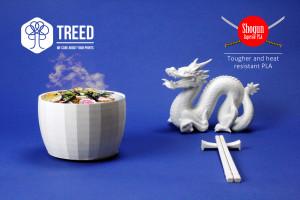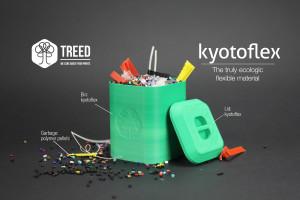Filament manufacturer TreeDFilaments has made a name for itself for proposing a wide range of exotic filaments to the market, from mineral based to high strength technical materials. For its latest products the company has turned to the Far East for inspiration by launching the new Shogun Superior PLA and kyotoflex ecologic flexible materials.
The Shogun Superior PLA is a new tougher blend of PLA which offers increased temperature resistance, being able to withstand temperatures of up to 90°C without suffering any deformation. Compared to TreedFilament standard Ecogenius PLA, it is up to 20% more resistant and is thus indicated low end mechanical applications.
This is done without compromising the material’s eco-compatibility. The Shogun Superior PLA is graded as fully biodegradable according to the EN13432 European ruling regulating biodegradability and compostability of polymer materials. No compromise has been made in terms of printability as well, since no heated plate or closed build chamber is required to avoid warping.
3D Printing with the Environment in Mind
The second new material also takes a popular trait in filament, flexibility, and improves it in terms of eco-sustainability. Its name inspired by the beautiful ancient imperial Japanese capital, kyotoflex is the first flexible filament that is also fully biodegradable. Available only in a matte green, to better convey its “green” factor, it is also easier to print than most flexible materials, even — according to TreeD — with bowden extruders. Recommended nozzle temperature is around 200°C and plate temperature should be set at a maximum of 40°C.
Kyotoflex was developed to ensure a good elongation at break, coming out with a 47 shore/D flexibility (similar to certain TPE polymers). It also offers a low hygroscopy level meaning it can be stored for longer periods without losing its mechanical properties. Ancient Japanese traditions can be an inspiration for many positive elements, from willpower strength to harmony with nature. All aspects that work just fine in a 3D printing filament.
Subscribe to Our Email Newsletter
Stay up-to-date on all the latest news from the 3D printing industry and receive information and offers from third party vendors.
You May Also Like
Printing Money Episode 17: Recent 3D Printing Deals, with Alex Kingsbury
Printing Money is back with Episode 17! Our host, NewCap Partners‘ Danny Piper, is joined by Alex Kingsbury for this episode, so you can prepare yourself for smart coverage laced...
Insights from Cantor Fitzgerald on AM’s Q1 2024 Landscape
A recent survey by Cantor Fitzgerald sheds light on the persistent challenges within the additive manufacturing (AM) industry in the first quarter of 2024. Based on responses from 38 industry...
3D Printing Financials: Xometry’s Scaling up and Strong Start to 2024
Xometry (Nasdaq: XMTR) kicked off 2024 with strong results, boosting its marketplace and technology to new heights. Both revenue and gross margin soared, fueled by an expanding global network of...
3D Printing Financials: Desktop Metal Targets Recovery Amid Net Losses and Revenue Downturn
Despite facing a decline in revenue and the persistent challenges of a tight economic climate, Desktop Metal (NYSE: DM) is making strides toward operational efficiency. The first quarter of 2024...


































